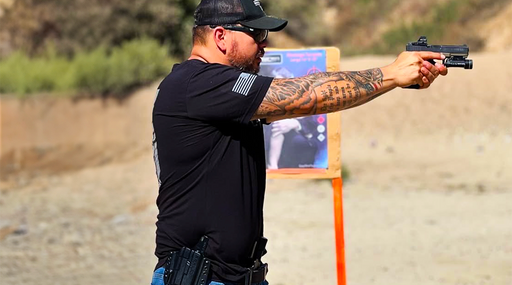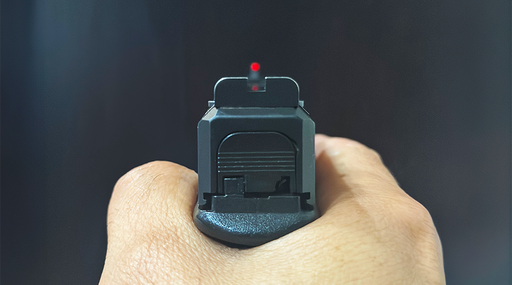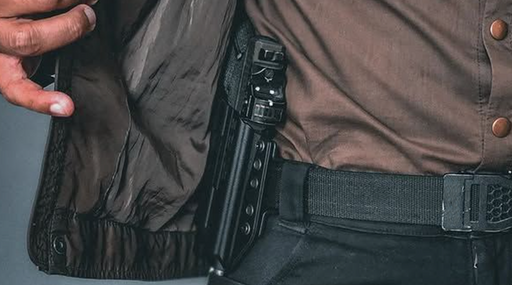Gun Holsters for Women: the good, the bad, and the ugly?

There’s a tongue-in-cheek expression in the CCW community, “pick a holster you love, and buy the gun that fits it.” It may be a joke, but it’s not far off the mark. The holster that causes physical pain or constant effort to keep concealed will not be worn for long.
Added to the comfort equation, and what should be top of mind, is safety. Sadly, there are many holsters that fail the safety test.
A “good holster,” in my book, is easy to define, as it does three things:
- It allows quick and easy access to your firearm.
Most violent criminal encounters begin and end in less than five seconds. Have you tested your carry system against a timer?
- It protects the trigger guard from any unintended penetration.
Cutesy tights and lacy wrapped contraptions may be attractive, and potentially deadly to YOU. Any garment or so-called holster that permits penetration by, say, a toddler’s fingers, your dog’s toenails, or the stick you stumbled into is little more than an accident waiting to happen.
- It keeps the gun where it belongs.
You should be able to put your hand on the holster/gun and obtain a firing grip with little to no fiddling around. The gun should never, in the context of your active days, have the chance to fall out of its hiding place. Nor should the holster allow the gun to shift around so much that you’re constantly distracted by having to fix its position.
What’s not on this list? Adequate concealment of the gun, for one. That’s on you, not the product. Deciding that life is worth defending is a big step for many people. Your commitment to that decision can often be gauged by whether, or what, you’re willing to give up in order to carry concealed on a daily basis.
Popular choices of carry methods for women I know who are committed to EDC include:
Inside waistband (IWB)
IWB methods can be in the front of the body, so-called appendix position, from 12- to 2:30 if your waist had clock digits and you’re right-handed, or 9:30 to 12-o’clock for left-handed shooters. IWB can also be done at the 9- or 3-o’clock positions, or somewhere in the small of your back with a sturdy holster.
With a garment covering the waist, IWB offers perhaps the best access to the gun of any method. I have come to dislike carrying behind the midline of the body for two reasons: many holsters that are comfortable to wear around the back are also cumbersome to put on, and most important, there are too many incidents of theft of guns being carried in this position. Carrying behind the back makes printing of the grip almost inevitable during even a mildly active day. That little outline is just too much temptation for some thieves—most of whom point their newly acquired gun at the surprised owner as they backpedal to an escape route.
Appendix IWB (AIWB) is the method I have come to use, after much trial and error. For myself, it meant compromising and carrying a smaller gun than I wanted to. Anything with a shorter sight radius is representative of the obligation to be excellent with the fundamentals of sight alignment and sight picture. These can fall apart comparatively faster with a short barrel. But a short barrel is the only thing that short-waisted me can accommodate without developing a blister on my thigh from the muzzle or holster-end poking me in the leg. Did I just say muzzle poking me? A basic requirement of AIWB, or any waistband carry, is that your control of where your fingers are in relation to the gun Is firmly in place, and that you neverhave any digits inside the trigger guard until the sights are on target and you’ve decided to fire. Lots of people get freaky-paranoid about AIWB carry for safety reasons. If your holster meets the “good” criteria above, and you can keep your fingers where they belong in relation to the gun as a matter of habit, then you’re ready for IWB. If you can’t wholeheartedly agree with those criteria, please avoid IWB carry for your own safety.

Many women find that a Kydex holster fitted with a wedge or other extension to push the grip toward the body to be both comfortable and liberating in that it enables carry of a mid-size, AKA compact handgun in the appendix position. These holsters solve a common and annoying issue many people experience with inside-waistband carry, the grip’s tendency to protrude and belie your armed status.
The Torsion gun holster by Bravo Concealment meets all safety and quick access criteria. It’s also easy to customize in terms of angle of carry, as it can be worn with only one clip. That one clip makes it quick and easy to put on also—a trait you’ll also probably demand if, like most people, you’re in a hurry to dress and get out of the house in the morning.

Ankle/lower leg carry
Neoprene ankle wraps, capable of carrying a gun, extra mag, and lip gloss are finally on the market. Though I’ve never tried one, I can imagine these are an improvement upon the old dog harness-looking type of ankle holster. Either way, plan on carrying a sub-compact firearm, as either rig will shift around with much weight attached.
A close friend and survivor of an armed robbery loves her ankle holster, which she uses with a Ruger LCP .380. When she went back to retail work, she swore she’d never again be unarmed at work. But working in a busy kitchen where a gun on the midriff would soon be detected by a co-worker forced her to be creative. She took that old-fashioned, abrasive ankle holster to a local shop that does alterations and can sew with heavy materials. Her holster is now luxuriously sheepskin-lined, and she wears it everywhere, her gun comfortable and more or less accessible on the inside of her support-side ankle.
Ankle carry option is one of the best methods for avoiding a fuss over concealment, assuming you wear pants that aren’t straight-leg or skinny style. The downside to ankle carry is a slower, labor-intensive draw.
Belly bands/corsets
A belly band or corset is made with one or more pouches for a firearm, magazine, or other items. Most are elasticized and secure with Velcro. One popular brand secures with hooks like those on a bra.
As mentioned previously, any holster that fails to retain the firearm in a constant and predictable place is not safe. Such was the case when I tried a belly band from a company specializing in women’s holsters. It was quite alarming to feel my Glock 42 slip halfway out of its compartment when I reached under the work conference table for a dropped pen! The incident ended well enough, with me excusing myself for a restroom break and hoping no one would notice me squeezing my upper arm against my side to hold the gun in place as I left the room.
Retention in a soft-sided belly band can come from a noisy Velcro tab, a user-added strap that snaps in place, or, in the case of a well-known corset, a layer of material covering the rear of the slide. In any case, these features slow down access and require fine motor skills to undo—the fewer fine motor demands you put on your body in a crisis, the better you’ll perform!
Soft sides on a belly band or corset can represent a safety hazard in terms of unintended entry of objects into the trigger guard. This might be remedied by wearing the band low and inside your pants, where two layers of fabric might provide better protection if the pants aren’t also paper-thin.
One very good belly band features a Kydex shell that resolves both the retention and penetration concerns. The shell is attached with Velcro, at the user’s choice of angle, to an elasticized band covered in loop material. This holster, by Crossbreed, is the only one I can say meets safety criteria. The corset company offers, at a fee, a stiff insert for the gun holster sleeve to protect against penetration.
I tried hard to make a bellyband work when I was an office-bound professional. After all, it offers the ability to wear a dress or tuck in a blouse. Perhaps others have had better experiences, but I found no place, from just under the bustline to the hips, where the band would stay in place and not have the gun shift around without having it really tight. I don’t mind snug clothing, but it turns out my digestive system objects to being bound up inside an elastic tube for eight hours. And just like that, another holster was tossed into my discard box—the one item most longtime concealed carriers have in common.
A simple sheath
For many years, I got by with a holster that, at face value, fails on the retention test. There are a couple brands of neoprene-like, generic-shape sheaths made for IWB carry. I’ve worn two brands and, with a belt or tautly secured drawstring singing backup on the retention song, these proved a success for most activities. I could run, ride my horse, mow the lawn, and so on with the holster in my waistband. Drawing was fast and easy. Re-holstering is a bit of a pain, as the sheath must be removed and the gun inserted first before re-setting the holster. I would not recommend this type of holster to women who are doing physical labor that involves lots of bending forward or stretching up; these actions could potentially make the gun break loose. I’ve done yoga sessions with these holsters, but concentration is compromised due to the risk of the holster or gun falling out.
If you’re going to try the sheath route, check out my tip on how to tie a waistband drawstring so it’ll act like a belt for your gun holster here.
Purse carry
Carrying in a purse seems, at face value, like a perfect solution if you don’t want the gun to interfere with fashion. Purse carry is by far the most cumbersome when it comes to training for the draw stroke, especially if you’re going to do it without muzzling your own brachial artery as well as innocent people in your vicinity. Any cross-body carry position, the only sensible way to purse carry, invites muzzling unintended targets during the draw. Safe and effective purse carry can be done, but it takes good gear and no small investment in practice. It is the most complicated and risk-fraught choice among common carry systems.
If you’re going to carry in a purse anyway, be sure to buy one that’s made for CCW, with a gun holster or sleeve inside. NOTHING other than the gun should go in the compartment with the holster! Innocent bystanders have been shot by clueless women who put a loaded gun in a purse and set the purse down in a public place. Keys, eye pencils, and the like have no business near a trigger guard.
Just say no to these holsters
It’s unfortunate that some companies, including a handful owned and operated by professional “gun people,” persist in marketing unsafe products for women. Among these are any yoga pants/tights that allow penetration of the trigger guard from the outside. Then there’s the lacy wrap that, if you’re crafty enough to whip it around your torso, shoulder, or thigh to create a holster out of a big length of fabric, every day will be an experiment of whether the gun will stay in place. Thigh holsters are all the rage on social media, mostly on pages frequented mostly by men. The bedroom is probably the best place for a thigh holster! Most thigh holsters offer either comfort or concealment, but not both.
Figuring it out
If you’re frustrated by now that I’ve only hinted at the perfect carry method for women, don’t be. Look forward instead to experimenting, safely, with your gun as you find out what’s comfortable to wear, easily concealed by your typical outfits, and reasonably accessible. There is no typical woman’s body. Dimensions of one body part do not predict another.
I hope I’ve saved you some money and time by eliminating from consideration any holster that doesn’t meet safety criteria. Some of those criteria, like retention, have gray areas. You have to decide what’s workable for your lifestyle and habits.
Women, generally speaking, enjoy more holster choices and certainly a wider range of fashion options than men. In order to make concealed carry work for you every day, compromise is necessary. I had to stop tucking shirts in to wear my preferred holster. Others may have to switch from dresses to skirts. The bottom line is this: having a gun in your possession should never be confused with readiness. Your ability to quickly deploy and effectively use that firearm are the real lifesavers.

Eve Flanigan is a defensive shooting and concealed carry instructor living in the American Southwest. Today she works full time as an instructor and writer in the gun industry. Flanigan loves helping new and old shooters alike to develop the skills needed to keep themselves and their loved ones safe.























Leave a comment